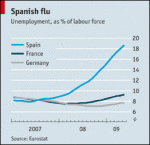

|
Economic Statistics - unemployment, inflation, etc..EmploymentSpain has two agencies publishing unemployment figures. EAPS is published by the Statistics office (INE), while more encouraging numbers come from the Labour Ministry (SEPE). In the latest Labour Ministry figures, from the labour ministry, unemployment fell by 0.63% to 4,714,122 in May. This was the second month in a row of falling claimants. Summer is seasonally the time of highest employment, due to tourism and agriculture. Latest data here from SEPE, the ministry's web.At May 2012 the SEPE has 4.714.122 claimants on its unemployment list. Despite new labour market regulations in early 2012 designed to make hiring and firing easier, unemployment shows no sign of truly falling. It is now 12% higher than a year ago. The June 2011 figure was 3.5% higher than June 2010. It ended 2009 at 3,923,603 rising above 4 million in January 2010. It is struggling to fall below this mythical figure, but at least is has not quite hit the 5 million mark, despite fears. The previous year saw a big rise to end 2008 at 3,128,963, an increase of 999,416 (47%) during 2008 - so 1.8 million over 2 years. At the end of 2007 it stood at 2,129,547. Construction contributed most of the new unemployed. Unemployment grew by 5% in 2007 after falling by some 80,000 during 2006, leaving the figure at 2,022,873. Total employment grew 3.1%, or over half a million jobs in 2006. Almost 900,000 new jobs were created during 2005. In 2006 over 18 million contracts were signed, of which 16 million were temporary. It was the first time over 2 million indefinite contracts were signed. The Social Security currently (June 2011) has 17,586,579 contributors. In 2006 it had a record year. The average number of people registered in the Social Security in April '06 was 19,109,008. Over 614,000 new people were added to the Social Security in the first 7 months of 2006, of which almost 30% were foreigners. At the end of 2005 there were also 1.733,465 foreigners in the Social Security, up 57% on 2004. By January, 2007, allowing the integration of Romania and Bulgaria into the EU, the figures were: 1,847,443 foreign workers, of whom 581,227 are EU citizens. 40% of the non-EU workers are from Marocco and Ecuador. There are rather over 55,000 Britons working here. About 20% or 380,000 foreigners working in the building industry. EAPS, another official survey which works out figures in a different way, currently paints a grimmer picture, putting the unemployment figure for q1 (2012) at 5,639,500 or 24.44%. Latest figures are available here- EAPS-pdf - only industry bucks the trend to shed jobs. The EAPS unemployment figure ended 2009 at 4,326,500 or 18.83%. For full details 2009 please consult the EAPS pdf file. It ended 2008 at 3,207,900, a rise of 2.58%, to 13.91% of the working population; 2007 ended at 1,927,600 or 8.6% (2006 year end 8.3%, which was the lowest year end total since 1979). At the same time, the total active population grew 2.7% to 23,064,700 (or 60.13%) of whom the occupied are 19,856,800 falling back below the 20 million mark. 489,000 jobs were lost over the quarter, 558,500 over the past year. |
